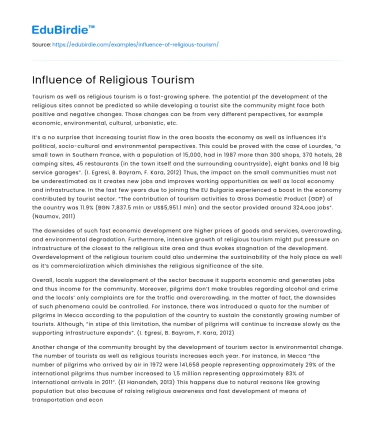Tourism as well as religious tourism is a fast-growing sphere. The potential pf the development of the religious sites cannot be predicted so while developing a tourist site the community might face both positive and negative changes. Those changes can be from very different perspectives, for example economic, environmental, cultural, urbanistic, etc.
It’s a no surprise that increasing tourist flow in the area boosts the economy as well as influences it’s political, socio-cultural and environmental perspectives. This could be proved with the case of Lourdes, “a small town in Southern France, with a population of 15,000, had in 1987 more than 300 shops, 370 hotels, 28 camping sites, 45 restaurants (in the town itself and the surrounding countryside), eight banks and 18 big service garages”. (I. Egresi, B. Bayram, F. Kara, 2012) Thus, the impact on the small communities must not be underestimated as it creates new jobs and improves working opportunities as well as local economy and infrastructure. In the last few years due to joining the EU Bulgaria experienced a boost in the economy contributed by tourist sector. “The contribution of tourism activities to Gross Domestic Product (GDP) of the country was 11.9% (BGN 7,837.5 mln or US$5,951.1 mln) and the sector provided around 324,ooo jobs”. (Naumov, 2011)
Save your time!
We can take care of your essay
- Proper editing and formatting
- Free revision, title page, and bibliography
- Flexible prices and money-back guarantee
The downsides of such fast economic development are higher prices of goods and services, overcrowding, and environmental degradation. Furthermore, intensive growth of religious tourism might put pressure on infrastructure of the closest to the religious site area and thus evokes stagnation of the development. Overdevelopment of the religious tourism could also undermine the sustainability of the holy place as well as it’s commercialization which diminishes the religious significance of the site.
Overall, locals support the development of the sector because it supports economic and generates jobs and thus income for the community. Moreover, pilgrims don’t make troubles regarding alcohol and crime and the locals’ only complaints are for the traffic and overcrowding. In the matter of fact, the downsides of such phenomena could be controlled. For instance, there was introduced a quota for the number of pilgrims in Mecca according to the population of the country to sustain the constantly growing number of tourists. Although, “in stipe of this limitation, the number of pilgrims will continue to increase slowly as the supporting infrastructure expands”. (I. Egresi, B. Bayram, F. Kara, 2012)
Another change of the community brought by the development of tourism sector is environmental change. The number of tourists as well as religious tourists increases each year. For instance, in Mecca “the number of pilgrims who arrived by air in 1972 were 141,658 people representing approximately 29% of the international pilgrims thus number increased to 1,5 million representing approximately 83% of international arrivals in 2011”. (El Hanandeh, 2013) This happens due to natural reasons like growing population but also because of raising religious awareness and fast development of means of transportation and economic prosperity of the countries. That all have a big influence on the environment. It’s been reported that travel sphere contributed “nearly 14% of the global greenhouse gas (GHG) emissions”. (El Hanandeh, 2013)
Today, according to the country of origin, tourists travel with different means of transportation. The most common mean for travelling is a plane but many tourists from local area tend to travel by car or bus. In fact, to the most popular destination of muslim religious tourists – Mecca – “domestic pilgrims and pilgrims from Yemen, Syria, Yemen, Palestinian territories, Israel, and former Soviet Union states mostly travel by bus. All local pilgrims are assumed to travel by bus”. (El Hanandeh, 2013)
In a study of Chester and Hovarth on passenger transport which also included data of the effects of infrastructure were claimed that greenhouse gasses emission as well as life-cycle energy inputs that include infrastructure equaled 63% for cars and buses, 31% for air transportation and 155% for railway system. However, on the example of pilgrimage to Mecca it was calculated that the infrastructure emissions equaled 11% of the global warming potential (GWP) of the event.






 Stuck on your essay?
Stuck on your essay?

